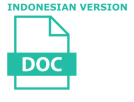Persepsi Mahasiswa tentang Kesulitan yang Dihadapi Saat Menempuh JLPT: Studi Kasus Mahasiswa Program Studi Bahasa Jepang Sekolah Vokasi Universitas Gadjah Mada
Lufi Wahidati(1*), Dinar Rahmawati(2)
(1) Universitas Gadjah Mada
(2) Wahana Gama Hashimoto
(*) Corresponding Author
Abstract
Japanese Language Proficiency Test (JLPT) is the largest-scale Japanese-Language test for non-native speakers in the world. This measurement tool is used by many companies and universities to assess the Japanese language skills of a job/scholarship applicant. The minimum standard expected by a company or university is the JLPT N3 level. Therefore, the majority of educational institutions in Indonesia that organize Japanese language programs set the learning outcome of its graduates to be equivalent to JLPT level N3. However, many students fail to pass the JLPT N3 exam before they graduate from college. In this study, a survey was conducted through a questionnaire to find out students' perceptions of the difficulties they encountered while taking the JLPT N3 exam. This study was conducted at the Japanese Study Program of the Vocational College of Uninversitas Gadjah Mada. Based on the results of the study, 88% of respondents found difficulty in answering Reading (Dokkai) and 62% of respondents found difficulty in answering Grammar (Bunpo) questions. Only 41% of respondents found difficulty in answering Vocabulary (Moji-goi) questions. Meanwhile, 59% of respondents found that the easiest exam questions were Listening (Choukai) questions. Generally, there are several factors that cause the difficulties. According to the students, the factor causing the difficulties in all types of questions (Reading, Grammar, Vocabulary and Listening) is the low mastery in vocabulary.
Keywords
Full Text:
PDFReferences
Babaiba, W. (2015). Reading Comprehension Difficulties among EFL Learners: The Case of Third-Year Learners at Nehali Mohamed Secondary School. Master thesis. University of Tlemcen. Retrieved July 2, 2019 from http://dspace.univ-tlemcen.dz/bitstream/112/7899/1/babayeba-wahiba.pdf
Cahyono, A.B, & Syartanti, N.I. (2017). Strategi Belajar Kelolosan Japanese Language Proficiency Test N1 (Studi Kasus Mahasiswa Sastra Jepang). Pramasastra: Jurnal Ilmiah Bahasa Sastra dan Pembelajarannya, 4 (1), p. 43-54. Universitas Negeri Surabaya.
Japan Foundation and Japan Educational Exchanges and Services. (2012). Japanese-Language Proficiency Test. Retrieved July 2, 2019 from https://www.jlpt.jp/e/about/purpose.html
Japan Foundation and Japan Educational Exchanges and Services. (2009). New Japanese-Language Proficiency Test Sample Questions. Retrieved July 2, 2019 from https://www.jlpt.jp/e/samples/pdf/N3-mondai.pdf
Rahmawati, D. (2014). Tingkat Kesulitan dalam Jenis Soal Kemampuan Nihongo Nooryoku Shiken (Studi Kasus Mahasiswa Prodi Bahasa Jepang Sekolah Vokasi Universitas Gadjah Mada). Tugas Akhir tidak dipublikasikan. Universitas Gadjah Mada.
Sutedi, D. (2008). Dasar-Dasar Linguistik Bahasa Jepang. Bandung: Humaniora.
Tjandra. S.N. (2014). Sintaksis Jepang. Jakarta: Bina Nusantara.
Article Metrics
Refbacks
- There are currently no refbacks.
Copyright (c) 2019 The Author(s)

This work is licensed under a Creative Commons Attribution-ShareAlike 4.0 International License.







